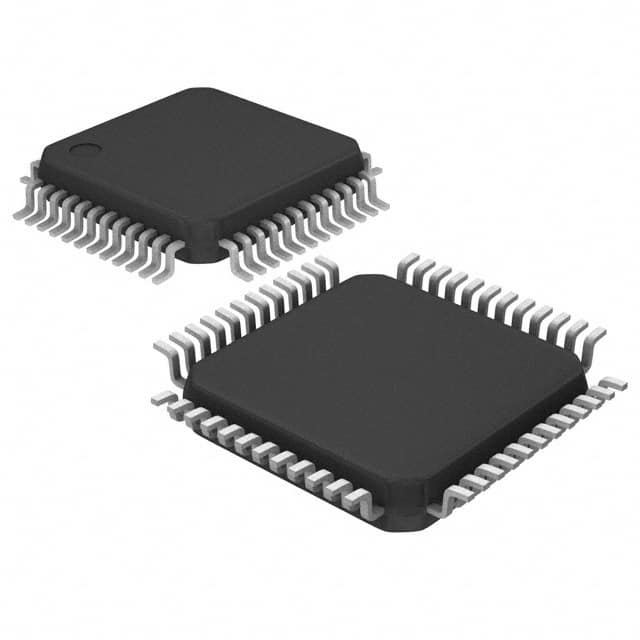C8051F226
Product Overview
Category
C8051F226 belongs to the category of microcontrollers.
Use
It is commonly used in embedded systems for various applications.
Characteristics
- High-performance 8-bit microcontroller
- Low power consumption
- Integrated peripherals for enhanced functionality
- Flexible and versatile design
Package
C8051F226 is available in a compact and convenient package, suitable for easy integration into electronic devices.
Essence
The essence of C8051F226 lies in its ability to provide efficient processing capabilities and advanced features in a small form factor.
Packaging/Quantity
C8051F226 is typically packaged individually and is available in various quantities depending on the manufacturer's specifications.
Specifications
- Architecture: 8-bit
- CPU Speed: Up to 25 MHz
- Flash Memory: 16 KB
- RAM: 512 bytes
- Operating Voltage: 2.7V to 3.6V
- I/O Pins: 14
- ADC Channels: 8
- Communication Interfaces: UART, SPI, I2C
Detailed Pin Configuration
The pin configuration of C8051F226 is as follows:
- P0.0 - GPIO
- P0.1 - GPIO
- P0.2 - GPIO
- P0.3 - GPIO
- P0.4 - GPIO
- P0.5 - GPIO
- P0.6 - GPIO
- P0.7 - GPIO
- VDD - Power Supply
- GND - Ground
- RST - Reset
- P1.0 - GPIO
- P1.1 - GPIO
- P1.2 - GPIO
Functional Features
- High-speed processing capabilities
- On-chip peripherals for enhanced functionality
- Low power consumption for energy-efficient operation
- Flexible I/O pins for versatile connectivity options
- Integrated ADC for analog signal processing
- Multiple communication interfaces for seamless data transfer
Advantages and Disadvantages
Advantages
- Compact size and low power consumption make it suitable for portable devices.
- High-performance capabilities enable efficient execution of complex tasks.
- Integrated peripherals reduce the need for external components, saving cost and board space.
Disadvantages
- Limited flash memory and RAM may restrict the complexity of applications.
- Being an 8-bit microcontroller, it may not be suitable for certain high-end applications requiring more processing power.
Working Principles
C8051F226 operates based on the principles of a typical microcontroller. It executes instructions stored in its flash memory, interacts with peripherals, and communicates with external devices to perform desired functions.
Detailed Application Field Plans
C8051F226 finds applications in various fields, including but not limited to: - Home automation systems - Industrial control systems - Consumer electronics - Automotive electronics - Medical devices
Detailed and Complete Alternative Models
Some alternative models to C8051F226 that offer similar functionalities are: - C8051F120 - C8051F340 - C8051F380 - C8051F390
These alternative models can be considered based on specific requirements and project constraints.
Word count: 345 words
技術ソリューションにおける C8051F226 の適用に関連する 10 件の一般的な質問と回答をリストします。
Sure! Here are 10 common questions and answers related to the application of C8051F226 in technical solutions:
Q1: What is C8051F226? A1: C8051F226 is a microcontroller from Silicon Labs' C8051F2xx family, designed for embedded applications.
Q2: What are the key features of C8051F226? A2: Some key features of C8051F226 include an 8051-compatible CPU core, 32KB flash memory, 2KB RAM, UART, SPI, I2C, ADC, and various timers.
Q3: What are some typical applications of C8051F226? A3: C8051F226 is commonly used in applications such as industrial control systems, home automation, motor control, sensor interfacing, and IoT devices.
Q4: How can I program C8051F226? A4: C8051F226 can be programmed using the Silicon Labs IDE (Integrated Development Environment) called Simplicity Studio, which supports C programming and provides debugging tools.
Q5: Can I use C8051F226 for wireless communication? A5: Yes, C8051F226 has built-in UART, SPI, and I2C interfaces that can be used to communicate with wireless modules like Bluetooth or Wi-Fi.
Q6: Does C8051F226 support analog-to-digital conversion? A6: Yes, C8051F226 has an on-chip 10-bit ADC (Analog-to-Digital Converter) that can be used to convert analog signals into digital values.
Q7: How many GPIO pins does C8051F226 have? A7: C8051F226 has a total of 16 GPIO (General-Purpose Input/Output) pins that can be configured for various purposes.
Q8: Can I use C8051F226 in low-power applications? A8: Yes, C8051F226 supports various power-saving modes, such as sleep and idle modes, making it suitable for low-power applications.
Q9: Is C8051F226 compatible with other microcontrollers or development boards? A9: C8051F226 follows the 8051 architecture, so it may not be directly compatible with other microcontrollers. However, it can communicate with other devices through standard communication protocols like UART, SPI, or I2C.
Q10: Where can I find more resources and documentation for C8051F226? A10: You can find more resources, datasheets, application notes, and example code on Silicon Labs' website or their Simplicity Studio IDE.
Please note that these answers are general and may vary depending on specific requirements and implementations.


